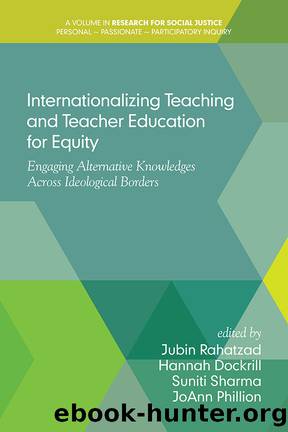Internationalizing Teaching and Teacher Education for Equity by Rahatzad Jubin;Dockrill Hannah;Sharma Suniti;

Author:Rahatzad, Jubin;Dockrill, Hannah;Sharma, Suniti;
Language: eng
Format: epub
Publisher: Information Age Publishing, Incorporated
Published: 2016-11-28T16:53:01+00:00
Chapter 7
Rethinking TechnologyââTechnology
As a Public Goodâ
Examining the Korean Governmentâs Policy for Bridging Digital Inequality
Sunnie Lee Watson
Abstract
The South Korean governmentâs policy of bridging the digital inequality in society is a notion of âtechnology as a public good.â South Koreaâs Master Plan for Closing the Digital Divide first launched in 2001 and has been continually renewed and updated for implementation for over a decade. In 2012, the Korea Communications Commission reported that 82.3% of all households in South Korea had broadband access (Park & Kim, 2014). Overall, this policy has been considered very successful in its implementation, becoming a uniquely successful example of information and communication technology (ICT) development through government policy implementation. In this chapter, I examine the notion of âtechnology as a public goodâ through the Master Plan for Closing the Digital Divide policy and explore how the policies were implemented and appropriated in the Korean cultural context. I also argue for the need for an enhanced understanding of the complex connections between digital divide policies, adoption of ICT use, and socioeconomically disadvantaged populations.
Introduction
In a society where knowledge-intensive activities are more and more important, the distribution of information across the population is increasingly related to divisions and stratification. Many optimists and information technology advocates have argued for the promise of information communications technology (ICT) in reducing social inequality, describing the current inequities in ICT access as temporary. These optimists and advocates, such as Rogers (1983), have argued that the benefits of technology will reduce inequality by decreasing the hurdles to information access, allowing people of all backgrounds to advance their human capital, strengthen their social networks, search for and find better jobs, and overall improve their quality of life by having the ability to access opportunities and information. However, others have warned that the rapid and uneven spread of Internet access across the population leads to increasing inequalities, advancing the situations of those who are already in privileged positions while disallowing the underprivileged opportunities for equal access (Hargittai, 2003).
Researchers, policymakers, and information technologists have paid attention to which parts of the population have access to the Internet and what sort of effects these trends have on society. Findings and arguments are mixed based on contextual factors, and the research clearly reflects that while the Internet has positive effects, it can also lead to further or new divides and inequalities (DiMaggio, Hargittai, Celeste, & Shafer, 2004; Van Dijk, 2012; Warschauer, 2004).
In this chapter, I review the implementation studies of the South Korean governmentâs policies on closing the digital divide. I specifically focus on their first digital divide policy, the 2001 Master Plan for Digital Divide Solution, which has been the most impactful and which takes the stance of âtechnology as a public goodâ in bridging the digital inequality in society.
The Digital Divide
The term âdigital divide,â often also referred to as âinformation gapâ or âinformation inequality,â is used to refer to the inequality between those people with effective access to powerful information technologies and those without access to it, particularly as embodied in the Internet (Norris, 2001).
Download
This site does not store any files on its server. We only index and link to content provided by other sites. Please contact the content providers to delete copyright contents if any and email us, we'll remove relevant links or contents immediately.
The Art of Coaching Workbook by Elena Aguilar(50161)
Trainspotting by Irvine Welsh(21070)
Twilight of the Idols With the Antichrist and Ecce Homo by Friedrich Nietzsche(18316)
The Secret History by Donna Tartt(18261)
All the Missing Girls by Megan Miranda(14842)
Cat's cradle by Kurt Vonnegut(14803)
Ready Player One by Cline Ernest(14060)
Talking to Strangers by Malcolm Gladwell(12912)
Fangirl by Rainbow Rowell(8812)
The Compound Effect by Darren Hardy(8541)
Thirteen Reasons Why by Jay Asher(8488)
The remains of the day by Kazuo Ishiguro(8427)
Periodization Training for Sports by Tudor Bompa(7939)
Tools of Titans by Timothy Ferriss(7848)
Wonder by R. J. Palacio(7755)
The Lover by Duras Marguerite(7603)
Change Your Questions, Change Your Life by Marilee Adams(7399)
A Court of Wings and Ruin by Sarah J. Maas(7303)
The Complete Stick Figure Physics Tutorials by Allen Sarah(7162)
